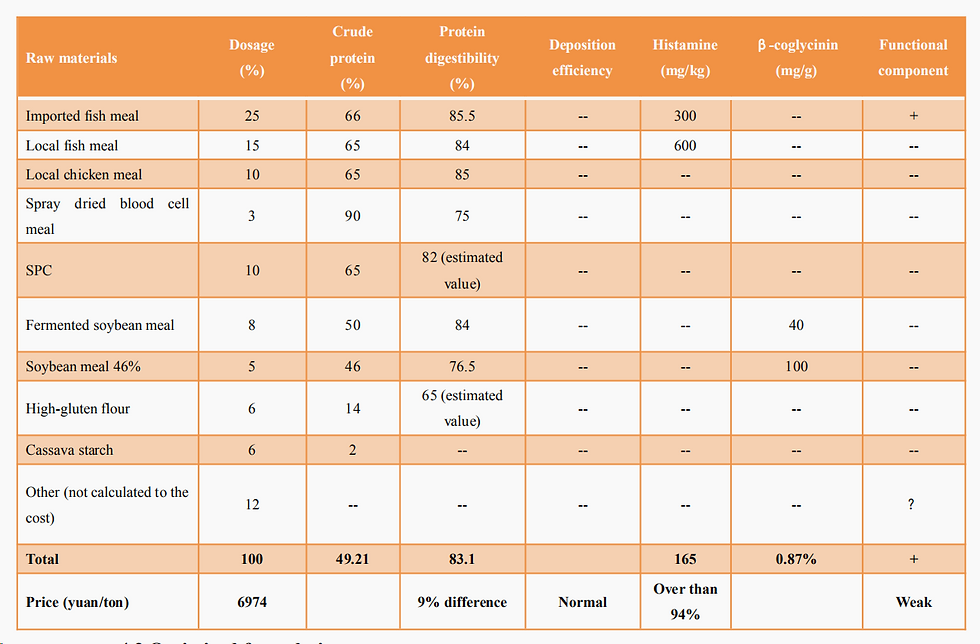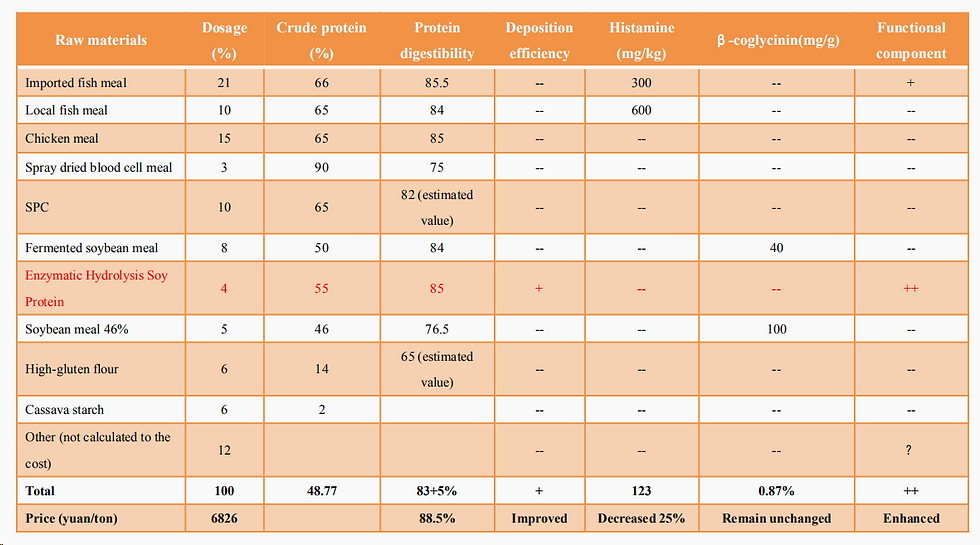Protein nutrition optimization help to reduce perch feed cost without any quality decrease
- Christy

- Apr 19, 2021
- 3 min read
The price increase of protein raw materials, such as soybean meal, fermented soybean meal, meat meal, etc., caused an increasing of perch feed by ¥ 200/ton! Feed mills have to sacrifice their profits since they cannot decrease the quality of feed for same cost, nor shift all the cost increased to the farmers.
Since perch feed request for high protein content, the dosage and costs on protein raw material is relatively high in whole feed. Therefore, optimizing protein nutrition has become a key measure to control the cost.
The previous article has shown a close correlation of protein level, structure, protein selection and combination to the development and health of the digestive tract, protein deposition efficiency, liver health and anti-stress ability of perch through a large number of researches, which indicates that protein nutrition strategy directly affects the quality and cost of perch feed. Well, how to design the protein nutrition of perch feed? Here’s the solution!
1 The protein nutrients level and structure in perch feed


2 Principles on the selection of proteins for perch feed
(“three highs”: high nutritional value, high health care value, and high stability)
2.1 High nutritional value
(high total absorbed and deposited protein = crude protein content * apparent vivo digestibility in fish * deposition rate)
A. Protein content: Crude protein is not the PROTEIN (18 kinds of amino acid composition need to be determined)
B. Apparent vivo digestibility in fish: perch has strong protein digestion capacity to feed. While, when raw materials digestibility is not that high or contain some negative factors, the digestion and absorption capacity of perch will be decreased.
a. In vivo protein digestion capacity of perch: up to 91-94% (Li songlin, 2020; He Ming, 2020)
b. The in vivo digestibility of different protein raw materials in perch: 75-85%

C. High deposition rate: The conversion of proteins into small peptides can increase deposition efficiency. Research shows that the deposition efficiency of small molecule peptides (2-3 peptides) is 1.5 times than that of amino acids (Le Guowei et al. 1998)
2.2 High health care value (low anti-nutritional factors, high functional components)
A. Anti-nutrional factors
a. β-Conglycinin: control within 1.5% (need to consider whether the conventional perch feed exceeds this standard or not?)
b. Histamine: control within 85ppm (need to consider whether the conventional perch feed exceeds this standard or not?)
B. Functional ingredients
a. Whether it could promote the intestine development and structure integrity of perch
b. Whether it could enhance the deposition efficiency of protein
c. Whether it could enhance liver health and anti-stress ability
2.3 High stability: stable quality, supply and price
[Summary] From the protein nutrition point of view, the high-quality perch feed needs to consider the three aspects: protein level, protein structure, protein selection and combination.
3 Analyze the current status of common protein raw materials for perch feed
3.1 Analysis on the common animal proteins
A. The animal protein digestibility in vivo of perch is high
B. Except for the functional ingredients in fish meal and enzymatic hydrolyzed fish lysate, most of animal protein have no functional components
C. Possible problems of fishmeal and enzymatic hydrolyzed fish lysate: protein putrefaction usually happen in storage and cause high histamine content; poor quality and supply, and the prices are generally high

[Remarks] The more + means higher content, ++++ means the highest degree
3.2 Analysis on common plant proteins
A. The plant protein digestibility in vivo of perch is lower than that of animal protein
B. Regular plant protein contains different amounts of anti-nutritional factors, and none of them have functional components
C. The quality and supply of plant protein raw materials are relatively stable, and the prices are generally low

[Remarks] The more + means higher, ++++ means the highest degree
4 Feed formulation of perch feed recommended by Mytech
4.1 Conventional formulation
A. Protein digestibility: the actual digestibility is 83%, lower than the expected value (91-94%)
B. Protein deposition rate: no ingredients that could enhance protein deposition efficiency
C. Histamine: actual value is 165ppm, higher than the expected value (85ppm)
D. β-conglycinin: actual value is 0.87%, lower than the expected value (1.5%)
E. The function of the feed: weak (only fish meal in the feed provides some function components)

4.2 Optimized formulation
A. Protein digestibility: actual value is 88%, 5% higher than conventional one
B. Protein deposition rate: rich in ingredients that can enhance the protein deposition efficiency
C. Histamine: actual value is 123ppm, 25% lower than before
D. β-coglycinin: actual value is 0.87%, the same as before
E. Feed functionality: strong (Enzymatic hydrolysis soy protein in the feed provides functional ingredients)
F. Feed price: reduced by about 150 yuan/ton

【Summary】
It is believed when the requirements as below being met, a high quality perch feed could be made.
A. Design appropriate protein levels (match other nutrients)
B. Comply the supply structure of "protein + peptide + amino acid"
C. Obey the "Three Highs" Principle, combining protein raw materials to meet the requirements








Comments